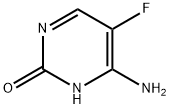2022-85-7

Product Name:
5-Fluorocytosine
Formula:
C4H4FN3O
Synonyms:
4-amino-5-fluoro-2(1H)-pyrimidinone;5-Fluorocytosine;Flucytosine
Inquiry
CHEMICAL AND PHYSICAL PROPERTIES
| Physical Description | Solid |
|---|---|
| Color/Form | White crystalline solid |
| Odor | Odorless |
| Melting Point | 296 °C |
| Solubility | >19.4 [ug/mL] (The mean of the results at pH 7.4) |
| LogP | -1.1 |
| Stability/Shelf Life | Stable under recommended storage conditions. |
| Decomposition | When heated to decomposition it emits very toxic fumes of /floride ions and nitrogen oxides/. |
| Dissociation Constants | 3.26 |
| Collision Cross Section | 118.4 Ų [M+H]+ [CCS Type: TW, Method: calibrated with polyalanine and drug standards] |
| Other Experimental Properties | Aqueous solutions, both acidic and basic, are stable. |
SAFETY INFORMATION
| Signal word | Warning |
|---|---|
| Pictogram(s) |
 Health Hazard GHS08 |
| GHS Hazard Statements |
H361:Reproductive toxicity |
| Precautionary Statement Codes |
P280:Wear protective gloves/protective clothing/eye protection/face protection. |
COMPUTED DESCRIPTORS
| Molecular Weight | 129.09 g/mol |
|---|---|
| XLogP3 | -0.9 |
| Hydrogen Bond Donor Count | 2 |
| Hydrogen Bond Acceptor Count | 3 |
| Rotatable Bond Count | 0 |
| Exact Mass | 129.03383992 g/mol |
| Monoisotopic Mass | 129.03383992 g/mol |
| Topological Polar Surface Area | 67.5 Ų |
| Heavy Atom Count | 9 |
| Formal Charge | 0 |
| Complexity | 208 |
| Isotope Atom Count | 0 |
| Defined Atom Stereocenter Count | 0 |
| Undefined Atom Stereocenter Count | 0 |
| Defined Bond Stereocenter Count | 0 |
| Undefined Bond Stereocenter Count | 0 |
| Covalently-Bonded Unit Count | 1 |
| Compound Is Canonicalized | Yes |
PRODUCT INTRODUCTION
description
Flucytosine is an organofluorine compound that is cytosine that is substituted at position 5 by a fluorine. A prodrug for the antifungal 5-fluorouracil, it is used for the treatment of systemic fungal infections. It has a role as a prodrug. It is an organofluorine compound, a pyrimidone, an aminopyrimidine, a nucleoside analogue and a pyrimidine antifungal drug. It is functionally related to a cytosine.
RELATED SUPPLIERS
Innovative
Mumbai
product:Powder White 5-Fluorocytosine (CAS Number: 2022-85-7), Packaging Size: 1 kg / 5 kg / 10 kg / 25 kg
